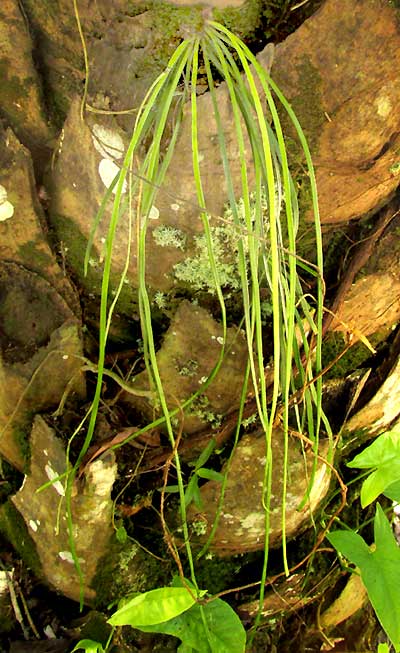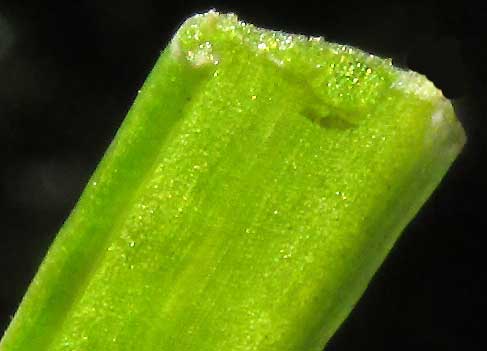Excerpts from Jim Conrad's
Naturalist Newsletter
from the May 4, 2019 Newsletter with notes on a March, 2019 camping trips into northern GUATEMALA'S lowland Petén department:
SHOESTRING FERN
Last March 28th, when I hiked into the campground of northern Guatemala's El Rosario National Park, on the east side of Sayaxché in the Petén department, one of the first things I did was to go check on the remarkable fern shown below:

That fern had caught my attention during an earlier visit there, in late September of 2018, but I'd not featured it here because it wasn't producing spores, and I thought I'd need to see the spore producing structures for a good identification. However, on my return to the park this March 28th, there still was no sign of spores. Maybe the plant shown is too immature, for they can form much larger bodies than the one shown.
This kind of fern produces its spore-producing sporangia inside the narrow fronds' curved-under margins. Below, a close-up of a cross-section of a frond shows the curved-under margins:

I'd known to look for sporangia beneath the curved-under margins because this is such an unusual fern that I'd read about it and seen it's pictures. Usually in English ferns looking like this are called shoestring ferns. They belong to the genus Vittaria.
In 1990 the genus Vittaria was regarded as having 50-80 species, but in 1997 many of the species were transferred to other genera, or declared to be the same as other species, so that now only six species are recognized, and those six can be hard to distinguish. However, our Guatemalan plant looks exactly like the most commonly occurring one, VITTARIA LINEATA, broadly distributed from Georgia and Florida in the US and the Caribbean area, south throughout Mexico and Central America, to central South America, so we'll park it under that name until someone advises us that it's not. Another reason for guessing that it's Vittaria lineata is that that speies is so robust and adaptive that it's "gone wild" as an invasive in several tropical counties.
Shoestring ferns mainly occur on the shaded, moist trunks of trees. In the US usually they're found on trunks of Cabbage Palms; in Rosario National Park, they're on trunks of Cohune Palms, where the fronds attach to the trunk, collecting organic matter and moisture.
Florida's indigenous Seminole people traditionally used Shoestring Fern to treat senility and depression, simply boiling the fern and giving the "tea" to the patient. The Guayami of Panama treated headaches with it.